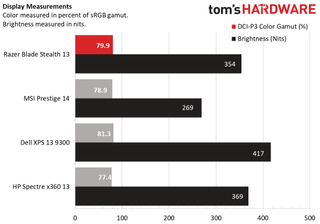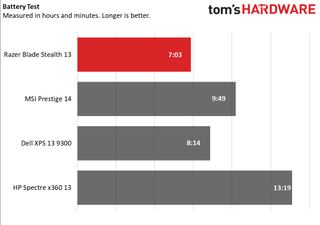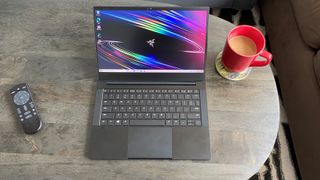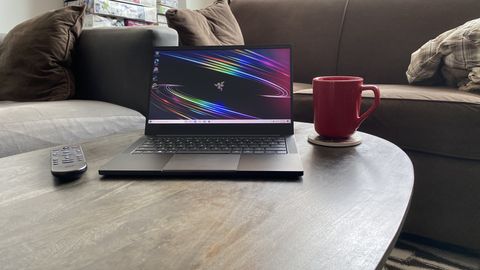Tom's Hardware Verdict
The Razer Blade Stealth 13 is an ultraportable with a discrete GPU, but it’s only good enough for light gaming experiences and isn’t as good at some other laptops in productivity tasks.
Pros
- +
Discrete GPU
- +
120Hz Display
- +
Slick design
Cons
- -
Subpar productivity
- -
Less than 8 hours battery life
Why you can trust Tom's Hardware
The Razer Blade Stealth 13 is an ultrabook that would really rather you think of it as a gaming computer. And to it’s credit, its dedicated GPU, looks, and 120 Hz screen back up that image. But while it’s perfect for older games and light esports titles, our testing shows that it’s still firmly a productivity machine first, although it struggles to lead the pack there.
That’s mostly because this is, at its heart, an incremental improvement over last year’s model. The key difference here is that it upgrades the graphics from integrated Intel Iris Plus to a dedicated Nvidia GeForce GTX 1650 Ti Max-Q. That’s enough for Razer to call this “the world’s first gaming ultrabook.”
The Blade Stealth 13 does try to stand out with its style and high frame rate display, but its size and specs put it in competition with ultraportables like the MSI Prestige 14 rather than the larger Razer Blade gaming machines that it looks like. In most modern games, it simply can’t keep up. It does have its niche, but what matters here is productivity. And although it may try to sidestep this issue with branding, we found that other, cheaper ultraportables beat it on what the category does best.
Specifications
| CPU | Intel Core i7-1065G7 |
|---|---|
| Graphics | Nvidia Geforce GTX 1650 Ti Max-Q |
| Memory | 16 GB DDR4 |
| Storage | 512 GB M.2 NVMe SSD |
| Display | 13.3 inch, 1920 x 1080, 120Hz |
| Networking | 802.11 ax |
| Ports | 2x USB 3.1 Type-A, 1x USB Type-C, 1x Thunderbolt 3, 1x 3.5mm combination headphone/microphone jack |
| Camera | 720p |
| Battery | 53.1 WHr |
| Power Adapter | 100 W |
| Operating System | Windows 10 Home |
| Dimensions(WxDxH) | 12 x 8.3 x 0.6 inches |
| Weight | 3.1 pounds |
| Price (as configured) | $1,499.99 |
Design







The Razer Blade Stealth 13 takes the minimalistic looks of Razer’s line of gaming laptops and crunches them down into a 13 inch ultrabook. At almost exact ruler length, it’s pretty cute to see a form factor that I’m most accustomed to seeing on beefy RTX rigs shrunk down to something I can do curls with. But it also works well - the small size really emphasizes the unintrusive look of the Blade design.
That design gives you a matte black shell with a sleek, professional appearance that almost feels like a jumbo business card. The only decorations here are the green USB ports and the glossy Razer logo on the lid, while everything else about this laptop’s style prioritizes function and keeping distractions out of the way. That means all of the Blade Stealth 13’s fans keep to the bottom of the laptop as well as on the part of the hinge that faces away from you. Opening the lid reveals the touchpad, chiclet style keyboard and upward-firing speakers, with no distracting branding or ornate design work to be found.
Overall, it’s an effective look, with my only major gripe being that the Blade Stealth 13 is somehow still a fingerprint magnet despite having a matte surface.
I could, however, do with more ports. The Blade Stealth 13 is almost symmetrical, with neither side offering too many options. The left side has a USB Type-C port, a USB 3.1 Gen 1 Type-A port and a 3.5mm combination microphone and audio port, while the right side has a Thunderbolt 3 port and another USB 3.1 Gen 1 Type-A port. I appreciate the inclusion of Thunderbolt, and it’s nice that I can plug the charger into either side of the laptop. But with most of the Blade Stealth 13’s ultraportable contemporaries at least having microSD card readers as well, I can’t help but feel like something’s missing.
Compromises are somewhat understandable when aiming to make a computer this small and lightweight, however. At 12 x 8.3 x 0.6 inches, the Blade Stealth 13 is in the middle ground among other ultraportable rivals, which is impressive given its inclusion of a dedicated graphics card. The MSI Prestige 14, which has the non-Ti version of the same GPU as the Blade Stealth 13, is for instance wider than at 12.6 x 8.5 x 0.6 inches. The HP Spectre x360 13 is also longer and thicker than it despite not having a GPU, coming in at 12.1 x 7.7 x 0.7 inches, but it has convertible functionality. While the Blade Stealth 13 isn’t quite as small as the GPU-less Dell XPS 13 9300, which is 11.6 x 7.8 x 0.6 inches, it still lives up to its name by packing decent graphics power into an ultraportable package.
Unfortunately, that power does mean it is heavier than all of its competition. At 3.1 pounds, it easily weighs more than the MSI Prestige 14’s 2.8 pounds, the Dell XPS 13 9300’s 2.8 pounds and the HP Spectre x360 13’s 2.7 pounds.
Productivity Performance
Unlike the other Razer Blades, being an ultrabook makes this more of a productivity laptop.
Under the hood, the Blade Stealth 13 packs an Intel Core i7-1065G7 CPU, as do two of the other computers we tested it against - the Dell XPS 13 and the HP Spectre x360. The i7-1065G7 is an Ice Lake processor that launched late last year, which makes it a little old but still plenty relevant for the ultrabook category. However, it does leave the Blade Stealth 13 at a disadvantage against one of the few other ultrabooks with a dedicated GPU, the MSI Prestige 14. This machine packs a Comet Lake Intel Core i7-10710U and an Nvidia GTX 1650 Max-Q. The Blade Stealth 13 has a slightly more powerful GTX 1650 Ti Max-Q GPU, but our numbers show it still struggles to keep up in productivity.




In our general productivity Geekbench 5.0 benchmark, for instance, the Razer Blade Stealth 13 scored the lowest among its competitors. At 3,972, it may have been just under the Prestige 14’s score of 3,982, but it was much further behind the Spectre x360’s 4,074 and especially the XPS 13 9300’s 4,848.
Our Handbrake testing also showed that the Blade Stealth 13 is slower than most contemporaries when it comes to video transcoding. While it took the Blade Stealth 13 17:20 to transcode a video down from 4K to FHD, the XPS 13 9300 finished transcoding in 15:40 while the Prestige 14 did so in 14:01. Of the computers we tested, only the Spectre x360 , which took 21:13 to transcode the video, took longer than the Blade Stealth 13.
The Blade Stealth had a reasonably quick file transfer speed. It transferred 4.97GB of files at a rate of 910 MBps, while the XPS 13 only reached speeds of 621 MBps and the Spectre X360 13 topped out at 318.1 MBps. The Prestige 14 was still faster than the Blade Stealth 13, hitting a file transfer rate of 1,017.9 MBps, but the Blade Stealth was competitive.
To stress test the Blade Stealth , we also ran it through Cinebench R20 on a loop 20 times. Here, it earned an average score of 1,480.2, only hitting a slight dip about halfway through. This was higher than its competitors’ averages, with the exception of the Spectre x360 . The CPU clock speed averaged 2.5 GHz during the loop, while its temperature stayed at an average 66.1 degrees Celsius throughout (150.9 degrees Fahrenheit).
Graphics Performance




Despite the Razer Blade Stealth 13’s pretensions of being a “gaming ultrabook,” the gaming niche it fills is pretty specific. While older titles perform well and casual play on esports games like League of Legends and Overwatch is more than capable, the Blade Stealth 13’s GTX 1650 Ti Max-Q failed to reach playable frame rates above 30 frames per seconds on modern AAA titles like Shadow the Tomb Raider and Assassin’s Creed Odyssey in our tests, which we run on their highest settings. For this card, you’ll have to tone things down.
Across our usual test suite of games, the Blade Stealth only had playable frame rates on Grand Theft Auto V (1920 x 1080, Very High) and Far Cry: New Dawn (1920 x 1080, Ultra). The former reached 36 fps while the latter went up to 48 fps. This makes sense, as GTAV is quite old at this point and Far Cry tends to be one of our less demanding games thanks to its strong PC optimization.
Thankfully, in my personal testing with Overwatch, I had the type of experience I was hoping for. Playing on high settings for a half hour, the game tended to drift between 120 - 130 fps, allowing me to get the most out of the high frame rate screen. Here, gameplay was buttery smooth with no noticeable lag, and the laptop only started to warm up and get noticeably- though not excessively- loud towards the end of my session.
I wouldn’t feel comfortable calling the Razer Blade Stealth 13 a AAA gaming computer, but if your only goal is to keep up with your friends in the most popular multiplayer games, it’s more than adequate for doing so.
Display

The Razer Blade Stealth 13’s display is bright and has a decent color range, but where it really shines is its blacks.
Watching the Tenet trailer in FHD on the Blade Stealth 13, the first thing I noticed was the poor viewing angles. In normal lighting conditions, I found that I couldn’t get more than 30 degrees from the screen either horizontally or vertically without the picture washing out. Moving the laptop to low light conditions helped increase viewing angles to about 45 degrees, but I still had my best experience when seated directly in front of the computer. Once I found my perfect spot, colors came across clearly though weren’t vibrant, but blacks were impressively deep and shadows crisp, with no blotches or bleeding whatsoever. The screen was also bright, which made action easy to follow.
I would generally call my viewing experience average, aside from the impressive blacks, which our testing backed up. With 79.9% DCI-P3 color coverage, the Blade Stealth landed around the middle of the pack compared to the MSI Prestige 14 (78.9%), the HP Spectre x360 (77.4%) and the Dell XPS 13 (81.3%).

The same held true for brightness, where the Blade Stealth 13 hit an average 354 nits, as compared to the Prestige 14’s 269 nits, the XPS 13s 417 nits and the Spectre x360’s 369 nits.
Keyboard and Touchpad

The Razer Blade Stealth’s keyboard is a single zone RGB chiclet style keyboard that suffers from shallow travel that makes typing strenuous and gaming unsatisfying.
The move from per-key RGB to zoned RGB for this smaller Razer Blade is unfortunate, as it takes away the greatest strength of Razer’s laptop keyboards- contextual lighting. But it’s also a key difference between gaming laptops and productivity laptops. Now, instead of the function row lighting up when you hold down the Fn key, the whole keyboard always shares the same color and effects. Still, that’s more than what most of Razer’s ultraportable competition offers, since you have a wide choice in colors and can even implement effects like breathing.
The Blade Stealth 13’s typing experience is lackluster and uncomfortable. Like most of Razer’s laptops, the travel here feels shallow, which means you don’t get much physical feedback.
On 10fastfingers.com, I usually hit between 65 - 68 words per minute while testing. That’s about 10 wpm below my standard, and doesn’t even take typos into account. But what’s more annoying is how sore extended typing sessions can leave your fingers, since the lack of travel makes it feel like you’re just repeatedly slamming them against a flat surface.
By contrast, the 4.4 x 3-inch glass touchpad feels smooth to the touch while offering just enough resistance to navigate your cursor and enter multi-touch inputs with ease, all of which register as they should thanks to its Windows precision drivers.
Audio
The Razer Blade Stealth 13’s two upward-firing speakers (located on either side of the keyboard) are loud and clear, giving the ultrabook a booming impression despite its small size.
When I listened to Daft Punk’s Digital Love on the Blade Stealth 13, I didn’t need to go over 60% volume to fill my whole 2-bedroom apartment with more than enough noise, and even at those levels, the song didn’t get distorted. When I lowered it down to more reasonable listening levels, I also found that it wasn’t tinny at all and that the song didn’t lose any of the bass track.
Upgradeability








If you have the right size Torx screwdriver (we used a T5), upgrading the Razer Blade Stealth 13 is easy. Simply unscrew the 10 Torx screws along its underside, then gently lift off the case with your fingers.
This will give you access to the SSD and Wi-Fi card, but like in many ultraportables these days, the RAM is soldered in. There’s also no slots for secondary storage, so you’ll only be able to swap parts rather than add on to the laptop.
Battery Life

The Razer Blade Stealth 13’s battery life is no slouch, but it unfortunately leans closer to what you’d expect from a gaming laptop than an ultraportable, which leaves it behind similarly specced contemporaries.
In our benchmark, which continuously streams video and runs OpenGL tests at 150 nits of brightness, the Blade Stealth lasted 7 hours and 3 minutes. That puts it well behind the Dell XPS 13 9300’s 12:39 battery life, and even further behind the MSI Prestige 14’s 9:49 battery life.
The HP Spectre x360 13’s 13:19 battery life is also far ahead of the Blade Stealth 13’s, although the Spectre’s score is so far above what we’d expect from this category that I’m hesitant to hold that against the Blade Stealth 13.
Heat
The Blade Stealth 13 gets somewhat hot during extended use, though you probably won’t feel it much thanks to the lack of side fans that blow hot air on you. As I pointed out earlier in this review, the keyboard can get warm when gaming, but not to uncomfortable levels.
To measure heat on the Blade Stealth 13, we logged its temperature after 15 minutes of streaming video on YouTube. We tracked both the laptop’s underside as well as key touchpoints like the touchpad and the center of the keyboard (between the G and H keys), and our results generally tended to land between 90 - 100 degrees.
The Blade Stealth 13’s underside was its hottest point, hitting 98.5 degrees Fahrenheit (36.9 degrees Celsius), while the center of the keyboard was the next hottest at 93.5 degrees Fahrenheit (34.2 degrees Celsius). The coolest area on the laptop was the touchpad, which registered at 83.5 degrees Fahrenheit (28.6 degrees Celsius).
It’s not unusual to see an ultraportable with such high temperature readings, especially when it has enough power to support discrete graphics.
Webcam
The Razer Blade Stealth 13’s 720p webcam is refreshingly accurate for this category, making up for its low resolution with strong color accuracy and texture capture.
Most laptops have 720p webcams that unfortunately tend to come with some grain and blur. The Razer Blade Stealth 13 doesn’t escape these issues, but unlike other ultraportables I’ve tested, also doesn’t make me look paler than I do in real life and doesn’t make textured objects look smoother than they should.
Pink looks pink on the Blade Stealth 13, and red looks red. You can expect accurate images here, and a smooth frame rate in videos. This most holds true across both regardless of lighting conditions, though I did lose some texture detail in low light.
If you want a 1080p picture, you're going to have to go external with options like those on our best webcams list.
Software and Warranty
The Blade Stealth 13 comes graciously free of bloatware, excluding what comes packed in with Windows. Unfortunately, we’ve seen Windows bloat getting a little heavy recently, so that doesn’t mean you’ll be free from having to sift through the Blade Stealth 13’s preinstalled software.
There is some genuinely helpful software, though. Dolby Atmos, for instance, gives you access to various post-processing effects for your computer’s audio, including virtual surround sound. But most of this laptop’s utility lies in Razer Synapse. This lets you control the Blade Stealth 13’s lighting, set macros for the keyboard and adjust performance and battery presets.
The Razer Blade Stealth 13 comes with a limited 1-year warranty.
Configurations
There are three configuration options available for the Razer Blade Stealth 13, with two of them featuring FHD screens and one opting instead for a 4K touchscreen. We reviewed the more advanced of the FHD options, which has a 13.3 inch 120 Hz display, an Intel Core i7-1065G7, an Nvidia GeForce GTX 1650 Ti, 16GB of DDR4 memory and a 512GB M.2 NVMe SSD. All of this goes for $1,499.99.
The other FHD configuration mirrors our review unit completely, although it only has a 60Hz display. It is normally $100 cheaper than our review configuration and can be found for $1,399, though some stores have it $100 more expensive due to recent changes in price across the line.
The Blade Stealth 13’s 4K option also mirrors our review unit’s inside specs, though it swaps out the display for a 60Hz 4K touchscreen. It costs $1,899.99.
Bottom Line

The Razer Blade Stealth 13 is in an awkward position for an ultraportable. It’s not quite as powerful enough at productivity tasks as similarly priced rivals in this category. Its 120Hz screen is unique for an ultraportable, but unless you only intend to use this laptop for non-demanding titles like esports, you won’t get much use out of it, as the GPU isn’t strong enough for many intensive games.
Typically, we tend to look at ultraportables for light office work rather than for gaming, and the Razer Blade Stealth 13 came towards the bottom of most of our tests here. If your goal is productivity, the slightly cheaper MSI Prestige 14, which also has discrete graphics and a Comet Lake processor, will suit you better around the board. The HP Spectre x360 13 might also serve well as a substitute for the Blade Stealth 13 here.
If you want a lightweight gaming machine, be warned that the Blade Stealth 13’s gaming uses are very limited. It can play older games and lightweight titles like League of Legends and even Overwatch well enough, but you’ll have to seriously turn down the graphics to play newer games like Shadow of the Tomb Raider, and still won’t be able to hit frame rates that are too high over 30 fps.
If price isn’t an issue and you don’t want to game, then the Dell XPS 13 9300, which lacks a discrete GPU but has the same CPU as the Blade Stealth 13, is the obvious choice. It greatly outscored all other computers we mentioned in this review on productivity, and has a slightly higher resolution 1920 x 1200 touchscreen for its display. But it’s also $1,799.99.
However, if your goal with the Razer Blade Stealth 13 is largely note taking and light productivity with a little bit of high frame rate multiplayer gaming on the side, then it is a strong choice.
Michelle Ehrhardt is an editor at Tom's Hardware. She's been following tech since her family got a Gateway running Windows 95, and is now on her third custom-built system. Her work has been published in publications like Paste, The Atlantic, and Kill Screen, just to name a few. She also holds a master's degree in game design from NYU.

